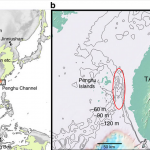East Asia
A new early human fossil has been reported, recovered from the seabed near Taiwan. We are calling it Penghu 1.
Simply put, it is the lower right jaw of a hominid (hominine) that most resembles either a form of Homo erectus or Archaic Homo sapiens (kin to, but not, Neanderthal). Teeth are fairly useful for categorizing hominids into groups that can be thought of as species. This hominid does not look like modern humans (teeth are way too big and the enamel is not right). It does not look like African Homo ergaster or Asian Homo erectus. It does not look like Neanderthal or so called…
Over the history of this weblog I have blogged about pigmentation a fair amount. The major reason is that that's where the money is; unlike height, let alone intelligence, the genetic architecture and evolutionary history of pigmentation has been elucidated with relative clarity. That is, we know roughly the number and nature of the genes which control much of the between population variation in pigmentation. And, we also have some sense of whether the variation is due to natural selection, as well the historical trajectory of the between population differences.
For example, consider the…
That's probably the big takeaway of a new paper on the genetics of Asians, a set which includes South Asians, but in the new research mostly focuses on the people of East Asia. In a global context this work is important. The backstory is that there are disagreements about the exact process of the "Out of Africa" migration. Most researchers would agree that the vast majority, perhaps all, of the distinctive genetic content of the human species derives from a migration from the African continent between 50 and 100 thousand years ago (closer to the former date than the latter likely). Note that…
